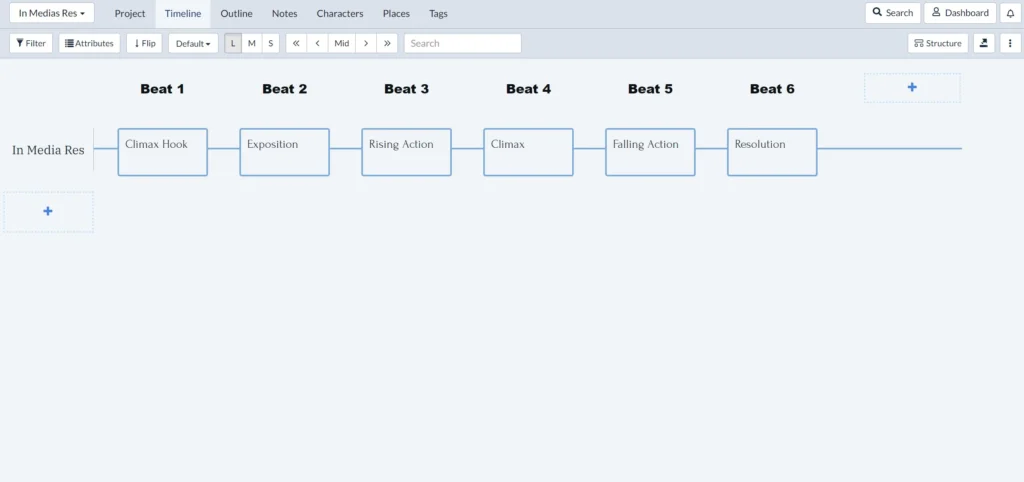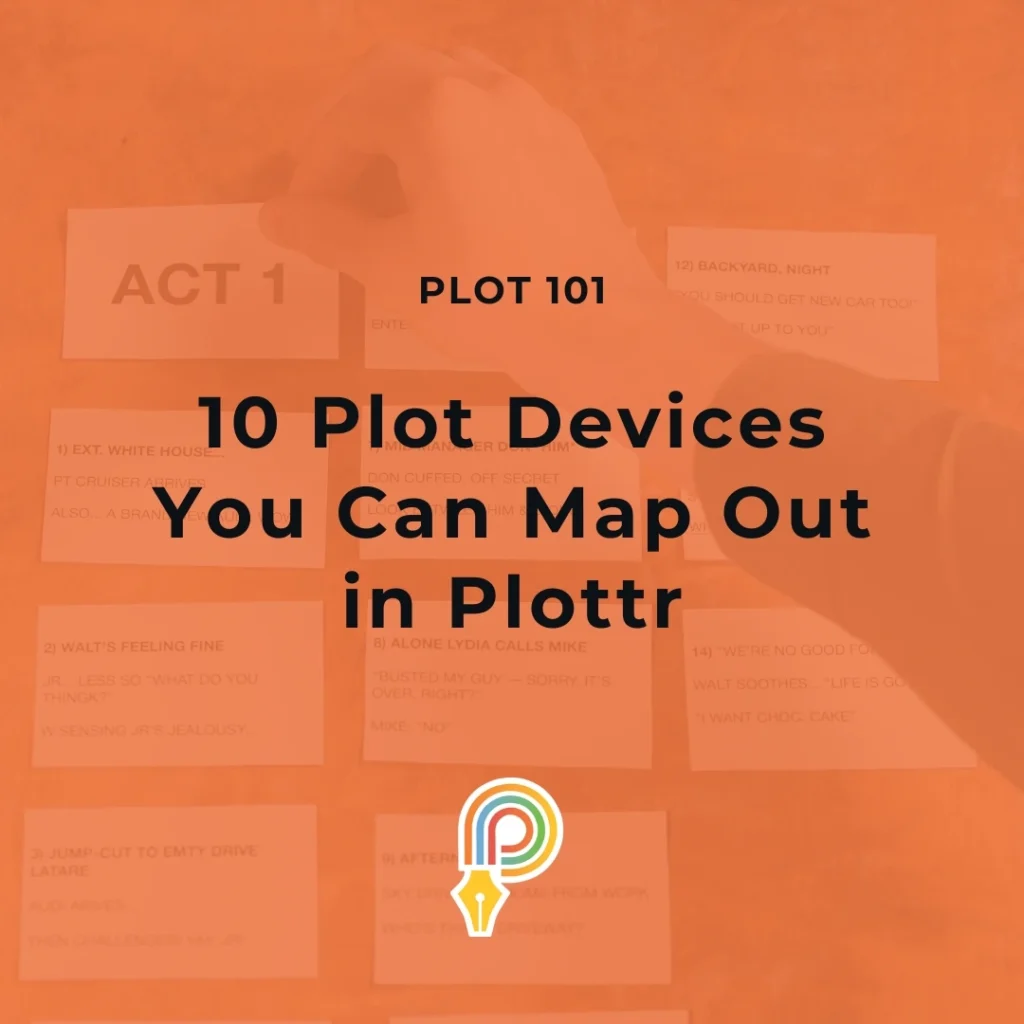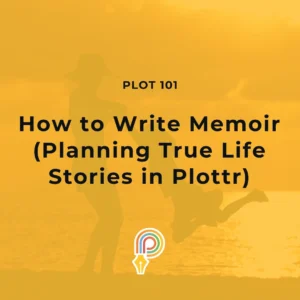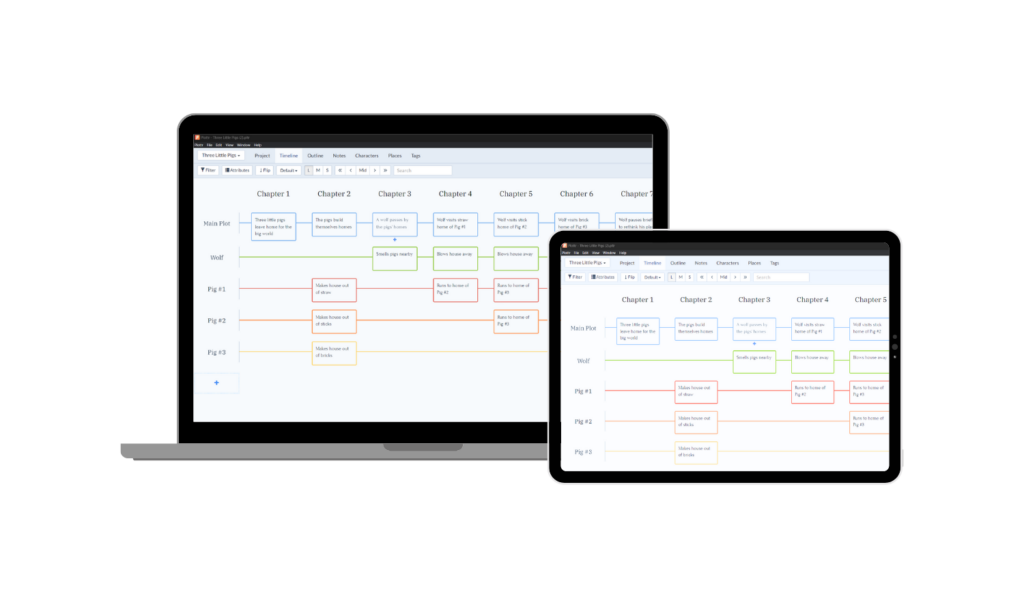Plot devices are like exclamation points. They add energy and surprise! But if you use too many, your story can feel rushed or messy. In this post, we’ll explore 10 common plot devices with fun examples and show you how to plan twists, turns, and big moments in Plottr.
What are Plot Devices?
Plot devices are storytelling elements that use time, change, items and even characters to create dramatic intrigue.
Ten plot devices that appear frequently in literary and genre fiction:
- In Medias Res: starting a story ‘in the midst of things’, without any introduction so that the action gets underway immediately.
- Plot Twist: an unexpected event that challenges the reader or audience’s assumptions and reshapes how they understand the story’s events.
- Turning Point: a pivotal moment that changes the story’s direction or a character’s trajectory.
- Reversal (peripeteia): a sudden reversal of fortune or change in circumstances.
- Foreshadowing: hints or clues that tease what will happen later in the story, creating anticipation.
- Flashback: a scene set in the past relative to the current narrative time. It gives context, adds backstory, and/or builds emotional weight
- Flashforward: a glimpse into the future. It’s often used to create mystery or irony.
- Time loop: characters relive the same sequence of events (or the same sequence of events is told from different POVs).
- Cliffhanger: a suspenseful ending that leaves a critical situation unresolved, creating the urge in the audience to continue.
- McGuffin: an object or goal that drives the plot, even if its specific nature isn’t very important to the story ultimately.
Read on for plot device examples. But first, why use them? And why should you use them with caution?
Why Use Plot Devices in Stories?
Plot devices help you add mystery, suspense, or extra meaning to your story.
Want to build suspense? Try a flashforward. It can make readers wonder how your hero goes from calm and happy to total chaos.
Need a big change? A reversal can flip a hero into a fugitive — or a fugitive into a hero.
Beware Overused Plot Devices (or Use Them for Parody)
Plot devices should be used with caution, too. As author K.M. Weiland shares, they can feel contrived. Sometimes, the story doesn’t show enough reasons for what happens. Some plot devices are used so often that they start to amuse us — even if the writer didn’t mean them to.
The sci-fi comedy animation series Futurama parodied how soap operas use amnesia as an absurd plot device in the show-within-a-show, All My Circuits. This reframes the device in a droll, surprising way. Other overused plot devices from the world of soap operas? Surprise babies, secret or evil twins, and faking illness to win love, support, or custody.
Let’s explore how to use plot devices (and map them out in Plottr):
How to Use In Medias Res: Starting Mid-Action
Starting the story in the middle of the action means no slow build-up, just boom! …you’re in it.
This classic plot move shows up in almost every James Bond movie. The idea is to begin with something exciting (not someone staring at a wall). Then, go back and explain what happened and why — so readers care about what’s going on.
Example: The opening of John Wick shows an SUV crashing into a wall and a bloodied man crawling out of it.
How to Use the In Medias Res Plot Device in Plottr
You can use this plot device several ways:
First, the In Medias Res starter template in Plottr gives you six scene cards to fill out. These help you start your story right in the middle of the action.

Second, you can plan your story from beginning to end. Then, use the Outline tab to move scenes around and start with a tense, exciting moment before backtracking to your inciting incident. This makes your story feel more mysterious and fun.
Creating Plot Twists: Reshape Perception with Reveals
One of the most famous plot twists of all time is just four morbid words: “Soylent Green is people.”
A twist doesn’t necessarily need to have huge shock value. It can feel obvious if it seems calculated for shock value only. It must serve the story.
An ironic twist is where a character’s actions or words have the opposite effect to what they intended, leading to a funny or tragic outcome.
Example of an ironic twist: In the dry comedy series Arrested Development, the Bluth family owns a frozen banana snack stand. The father of the family, who’s in jail for fraud, keeps saying, “There’s always money in the banana stand.” His kids think he means they should burn it down for insurance money — so they do. But later, they find out he meant it literally… the walls were filled with cash.
How to Plan and Visualize Plot Twists in Plottr
Here are some of the creative ways you can plan and visualize plot twists for your next story:
- Use color-coding to identify scenes where you reveal major twists. For example, you could make any scene card that challenges your reader’s understanding of events so far red.
- Give plot twists their own timeline. In the Timeline view in Plottr, make a plotline called “Plot Twists.” Then, add a scene card where the twist happens. Place it in the chapter, scene, or beat column that matches the spot in your story.
- Tag plot twists for easy filtering. Create a tag for plot twists in the Tags view. Then tag each scene card where a twist occurs. When you use the Filter button in the top navigation, you’ll be able to filter your outline to see only scenes where twists unfold.
Using Turning Points: Change Course for Dramatic Effect
A big twist in the story or a sharp turn in a character’s path can take your breath away. To make it work, show clear reasons for the change so it feels real and earned.
Turning point example: Take Romeo’s banishment in Shakespeare’s Romeo and Juliet. It occurs after he kills Juliet’s cousin, Tybalt, in a fight. This is a turning point that marks where Romeo and Juliet go from starting to explore their mutual infatuation to making a series of choices that lead to their deaths.
How to Map Turning Points in Plottr
Here are some ways you can plan and visualize turning points in Plottr:
- Start scene cards on a new plotline labeled “After [action]” For example, ‘After Romeo Kills Tybalt’ is the new plotline that begins with its first scene card after that event
- Tag your turning points (like we suggested tagging plot twists above)
- Use a plot template with built in turning points. Many of our templates include scene cards for turning points with tips on how to execute them flawlessly
Reversals: Showing Sudden Changes of Fortune
Sudden changes of fortune shake up a story. Sometimes, they create mystery, too.
Plot device example: In Charles Dickens’ classic novel, Great Expectations, Pip gets a surprise fortune from a secret helper. This sudden change, called a reversal, leads to a plot twist we won’t spoil (hint: the helper isn’t who Pip thinks).
How to Plan Reversals in Plottr
Make a new category in the Notes view called “Reversal Ideas.” Use it to jot down ways your characters’ luck might change. Will someone rise in power or status? Will someone take a fall?
As with plot twists, you could also create plotlines for this plot device, placing a scene card wherever a character’s fortunes change with the how and why.
Plotting how your characters climb corporate ladders or fall back into old ways through toxic relationships will help you create vivid trajectories.

Foreshadowing: Implying Intriguing Futures
Foreshadowing can be mysterious, fun, or even a little spooky. Good foreshadowing gives clues about what will happen later. It’s what makes people want to read or watch your story again to catch all the Easter eggs.
Example: In The Hunger Games, Katniss’s archery skills and rebellious streak are shown early on. These details pay off big time later. Her symbolic connection to the Mockingjay is layered in long before it becomes literal. Subtle? Yes. Forgettable? Nope.
How to Plan Foreshadowing in Plottr
Create a Note category called ‘Foreshadowing Clues.’ Use this to track small clues you want to drop in your scenes — like a weird comment, a quick glance, or a strange old object. If it will matter later, add it now.
You can also create a ‘Foreshadowing’ plotline in the Timeline view. Add scene cards that highlight when you introduce each hint and when it pays off. That way, you won’t accidentally leave your Chekhov’s Gun gathering dust in the corner.
Using Flashbacks: Time Traveling on Purpose
Flashbacks are time-travel with a purpose. Used well, they spark intrigue, deepen character, and deliver emotional gut-punches. Used poorly? They stall the story like a traffic jam on Memory Lane.
Example: In The Notebook, flashbacks aren’t just romantic nostalgia: they are the story. Each return to the past builds tension in the present, layering emotion and revealing truth bit by bit.
How to Plan Flashbacks for Stories in Plottr
Create a “Flashbacks” plotline in the Timeline view. Drop scene cards where flashbacks happen, and make sure they connect to the character’s current journey.
Bonus tip: color-code these cards so they’re easy to spot at a glance.
You can also use Notes to sketch out key memories for each character. What moment from their past still shapes how they act today? What scar are they hiding?
Flashbacks should reveal — not distract. If they don’t push the story forward, leave them in the vault.
Flashforwards: Making the Future Mysterious
Flashforwards tease what’s coming, raise questions, and keep readers guessing how the story will get there.
As plot devices, they’re great for adding tension and dramatic irony, especially when what we see contradicts what we expect.
Example: In Breaking Bad, the pilot opens with a wild flashforward: a pants-less Walter White in the desert with a gun, wearing a gas mask, and driving an RV full of mystery. Instant intrigue.
The episode then rewinds to his normal life, and we spend the rest of the season inching toward that moment.
How to Plan Flashforwards in Plottr
Add a “Flashforwards” plotline in the Timeline. Put scene cards where you show the future, and further along, add cards for when those moments actually happen. This helps you build the mystery and keep the story clear.
Time Loops: Making Every Day Groundhog Day
Time loops trap your characters in a repeating day, event, or situation. Readers love watching them squirm, learn, adapt, or completely lose it.
This plot device’s repetition builds tension, comedy, or tragedy, depending on how your character responds to the déjà vu.
Example: In the classic Bill Murray movie Groundhog Day, Phil is stuck reliving the same day until he becomes a better version of himself. Each loop reveals more about the town, the people, and his own inner mess — until the emotional payoff finally breaks the cycle.
How to Plan Time Loops in Plottr
Create a “Time Loop” plotline in the Timeline view to map each loop.
Add scene cards for each major change: What’s different this time? What does the character learn (or fail to learn)? Are the stakes rising with each pass?
You can also use Notes to track the rules of your loop: when it resets, what starts it, and how it can be broken. This keeps things clear and helps your story make sense.
Time loops aren’t just repetition; they’re transformations in disguise. If each cycle moves the character closer to growth or disaster, your loop won’t just spin in place: it’ll soar.
Create Cliffhangers: Leave Readers at a Precipice
Cliffhangers leave your characters hanging and your readers eager to know what comes next. Used right, this plot device creates urgency. Used too often, and readers start to feel like you’re holding the plot hostage.
Example: Think Stranger Things season finales, where someone’s in danger, a monster’s lurking, or a secret is revealed… cut to black. Or The White Lotus episodes where several characters are heading back to a hotel where somebody nasty could come looking for them.
In these examples, the tension doesn’t just end the scene — it fuels obsession until the next episode (or book).
How to Plan Cliffhangers in Plottr
Create a “Cliffhangers” plotline and mark each turning point where you leave the audience hanging. These can happen at the end of scenes, chapters, or acts — anywhere tension needs a boost. Use the scene card to note what’s at stake and what’s unresolved, too.
You could even leave an incomplete sentence as an idea to come back t-…
In Notes, you might track types of cliffhangers you use — physical danger, surprise twist, unanswered question — to keep them varied and fresh.
Cliffhangers should make readers gasp, not groan. If the suspense feels earned and the payoff is satisfying, your audience will happily hang on.
Master the McGuffin: Using Props to Move the Story
The MacGuffin is one of the classic plot devices. It’s a thing that makes people act (such as a relic everyone wants to chase or protect, even if what it is doesn’t really matter).
It’s less about the object itself and more about how it motivates the characters and drives the plot forward, to put it another way.
Example: In Indiana Jones and the Raiders of the Lost Ark, the Ark of the Covenant is a McGuffin. Sure, it’s powerful and ancient, but what really matters is what people are willing to do to get it. The chase reveals character, stakes, and conflict.
How to Plan McGuffins in Plottr
Create a Note titled ‘McGuffin Details’ where you outline what your McGuffin is, why characters want it, and how it influences their actions.
On your Timeline, add a scene card each time the MacGuffin changes hands, grows in importance, or causes big tension. Use color coding to make it easy to spot.
“A McGuffin you see in most films about spies. It is a thing that the spies are after […] it’s always called the thing that the characters on the screen worry about, but the audience don’t care.” Alfred Hitchcock, interview with Dick Cavett.
Further Q&A about Plot Devices
No, but ask if the device you’re using serves your story. Devices to get characters into tricky situations work better than those that create unlikely rescues.
Use them when you want to propel your story, develop characters, create suspense or emphasize themes. Yet remember that device serves story (and not the other way around).
Plan and Visualize Plot Devices, the Fun Way
Ready to plan stories and track how and where you’ve used plot devices? Try Plottr free for 30 days.
What’s your favorite plot device or guilty pleasure trope? Comment below!







Comments